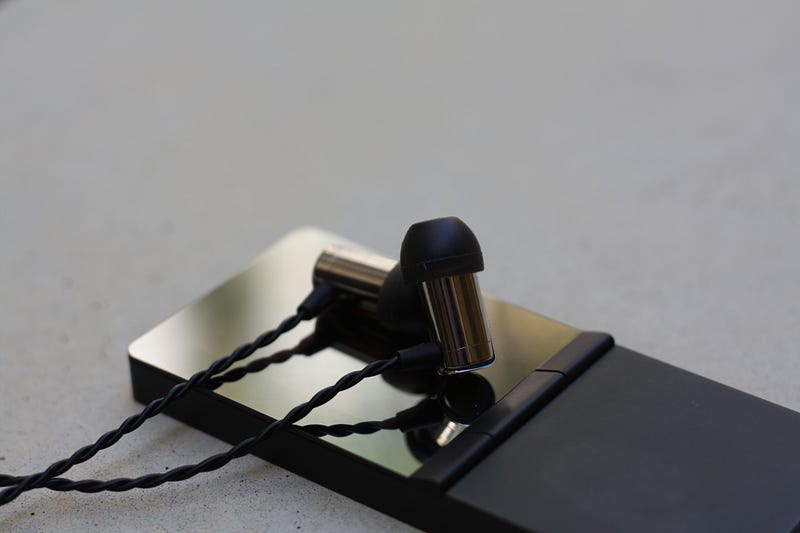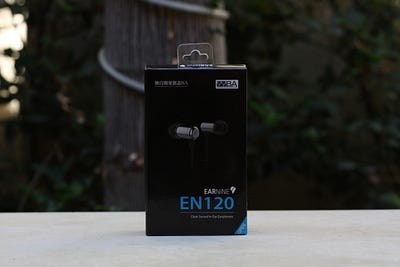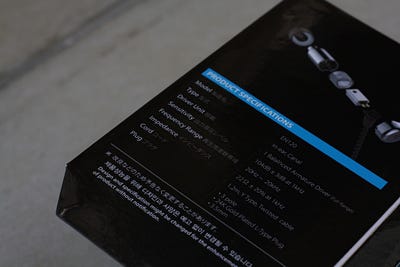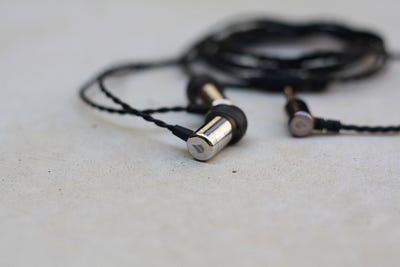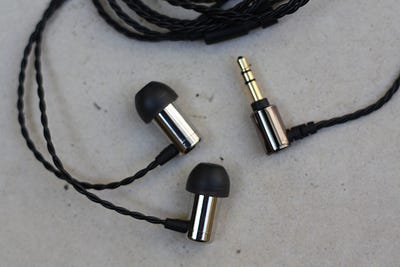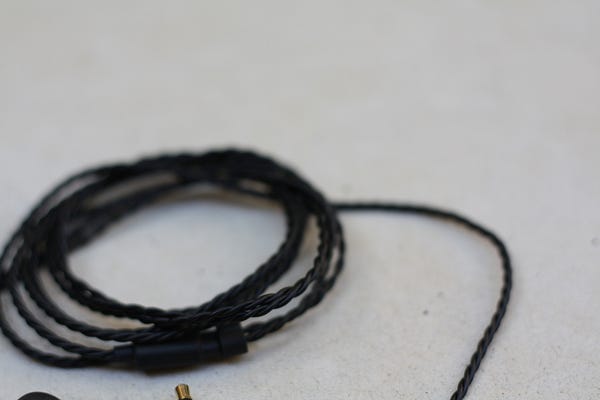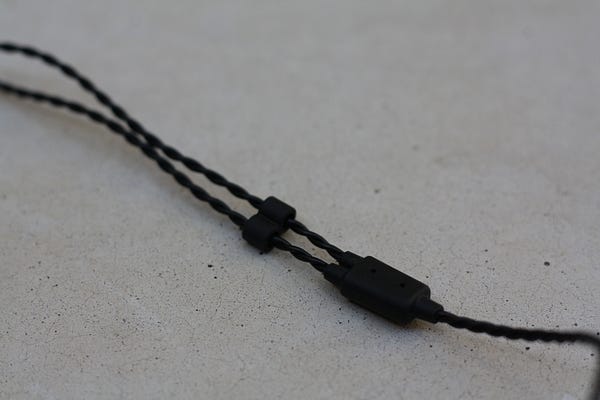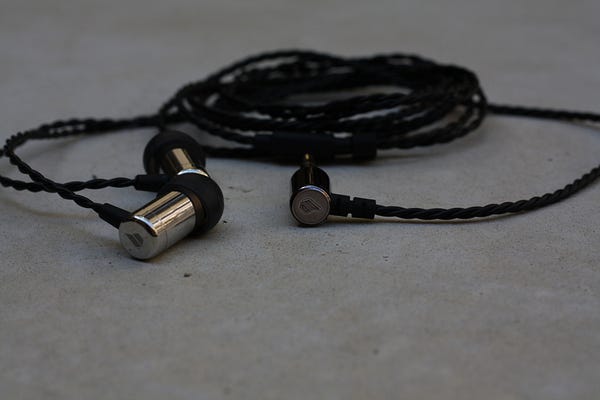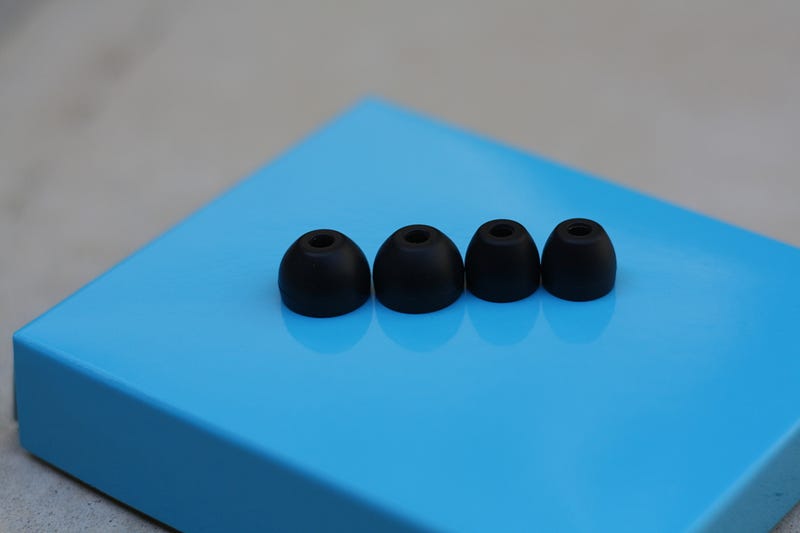Greetings Head-fi,
Today we are checking out EARNiNE's entry level product, the EN120.
As with the rest of the EARNiNE lineup, the EN120 is running custom built in house drivers. Just like the mid-range EN1J, it features a single full-range balanced armature (BA) driver per side. It features a stainless steel housing like the top-of-the-line EN2J, though this time in a more traditional barrel shape. I quite enjoyed the EN2J for it's insane detail output and the EN1J for it's lush, breathy mid-range. The EN120 makes for a great intro to the brand as it takes elements from both of it's stable mates and combines them into a more affordable package.
Let's take a closer look.
Disclaimer:
Thanks to Penon Audio and EARNiNE for arranging a complimentary sample of the EN120 for the purposes of review. All thoughts within are my own and do not represent EARNiNE, Penon, or any other entity, nor am I being provided any financial compensation to write this review.
The EN120 retailed for 79 USD at the time of this writing: https://penonaudio.com/earnine-en120.html?search=earnine
The EN120 on EARNiNE's site: http://earnine9.com/e9/?page_id=288
Source:
For at home use the EN120 was powered by a TEAC HA-501 desktop amp or straight out of my Asus FX53V laptop. For portable use it was paired with an LG G5, F.Audio S1, or Shanling M1, all of which brought it up to listening volume without much effort. I didn't find it particularly susceptible to hiss from any particular device, even through something like the F.Audio S1 which was designed mainly for running high impedance and difficult to drive headphones.
Personal Preferences:
I listen primarily to various EDM sub-genres (liquid drum and bass, breakbeat, drumstep, etc.), hip hop, and classic rock. While I enjoy a variety of signatures in my headphones I generally lean towards slightly warm with elevated treble and sub-bass, an even and natural mid-range response, with reduced mid-bass. The HiFiMan RE800, Brainwavz B400, and thinksound On2 offer examples of signatures I enjoy.
Specifications:
Packaging and Accessories:
The EN120's packaging is very simple and no unlike something you'd find in a retail store. It consists of a small black and blue cardboard box with a magnetically sealed front panel. The front panel shows off the EN120. The left panel outlines a few features like the use of BA drivers, a twisted cable, a noise isolating design, and the included tips. On the rear panel some of these features are elaborated upon. Flipping open the magnetically sealed panel you're greeted to a viewing window showing the EN120 itself and the 90 degree angled jack. On the inner left of the panel you find the specifications and a blown up image of how the earphone is constructed. Inside is a basic plastic tray along with the earphones and accessories. In all you get;
Build, Comfort, and Isolation:
The EN120 features either chromed or seriously well polished stainless steel housings with flawless fit and finish. Each component part fits together with nary a seam, the metal frills are stuck in place and fit perfectly, and even the strain relief is perfectly conformed to the shape of the housing. The cable I've already gushed about in my EN2J review. There I said;
“The cable is one of the nicest I've come across, though I wouldn't have guessed it on looks alone. At first glance it looks like those generic, overly thin braided cables found on countless budget earphones, but then you touch it. It weighs nothing. It behaves more like a piece of thread with extremely flexibility, NO memory, and almost no noise transmission. It is terminated in a compact, well-relieved 90 degree angled jack. The y-split is a compact and durable hunk of rubber. It has an effective chin cinch.”
The only difference here on the EN120 is that it is fixed to the earphone and there are no earguides. This lets you wear it over ear-or cable down with equal ease. And wear it you will because the EN120 is pretty darn comfy. It's a compact package with no sharp edges and simply nestles into you ear canals with no fuss. The included tips keep them stuck in place too, so even under heavy movement they still feel quite secure, even though they've got more weight to them than you'd expect given their size.
Many BA-only earphones are sealed, of which the EN120 is no exception. This plus the dense tips and thick housings make it great for drowning out exterior noise.
Sound:
The EN120 uses a single, full-range balanced armature. It produces a fairly neutral sound in the mids and bass, with a small lower treble bump to spice things up. This lightly boosted treble gives the EN120 a slightly bright edge. On poorly recorded tracks and those that are already heavy on the high end, the EN120 can come across a touch sizzly and uncontrolled. If you find that uncomfortable, I recommend picking up some foam tips which should help absorb those peaks. Like EARNiNE's other products, feeding it quality source material provides positive result and clears up these issues. I still recommend pairing it with a neutral to warm source though. This is a very revealing and detailed earphone, just like the EN2J, with a presentation that shows this off. The roll off in the upper treble regions is welcome as a result.
The EN120's mid-range is prominent but not set quite as far forward as on the EN1J. As with the EN1J and EN2J, there is a unique breathy quality, though it's not quite as prominent here. Female vocals exhibit mild sibilance as times and can come across a touch strident, but for the most past sound quite good. I would like them to have a bit more body, but that's where male vocals take off. They carry a more commanding presence with good weight and tonality. Texture and detail retrieval is strong without becoming overbearing or overshadowing.
Bass on the EN120 is reserved with a fairly neutral presence. Decay is quick and it handles snappy basslines with ease. As with the mid-range, texture is fantastic with grungy notes coming across as such. Nothing is smoothed over or softened. Mid-bass punch is actually fairly commanding, so while bass quantity is on the lower end, it still has a solid presence. Bass extension rolls off fairly early, as tends to be common with full-range BAs. You get hints of sub-bass, but no enough to carry tracks reliant on low frequencies.
Sound stage is where the EN120 is weakest, coming across fairly intimate. Depth and width impressions don't really extend much beyond your head, with the occasional effect thrown off on rare occasion into the distance. Imaging is very progressive and accurate and sounds are well layered. Separation starts to falter on busy tracks where elements start to blend together.
Select Comparisons:
UE600vi (discontinued): The UE600 is a classic single BA earphone that still sounds great by today's standards. While it's build quality doesn't hold a candle to the EN120, especially the cable, its design remains unique and slightly unconventional.
In terms of sound the two are somewhat similar. With a lean, light low end and prominent mids and treble, they both make for an energetic listen. The UE600 is a little more balanced as it offers up some additional gusto in the mid-bass. It also sounds larger and more spacious. The EN120 is smoother and a touch leaner with a more articulate and detailed presentation. It's imaging is also more accurate, and layering more apparent. Separation is equally good. The extra bite in the EN120's upper mids and lower treble takes away from long term listenability though, a quality which is very noticeable when swapping between the two. The EN120 also shares a breathy quality to the mid-range with it's EN1J and EN2J stable mates, which I find unique to EARNiNE's custom BAs. The UE600 obviously lacks this quality, which may or may not be a good thing to you.
Brainwavz B100 (49.50 USD): The B100 is a killer single BA earphone and was introduced with Brainwavz's new all-BA lineup last year. Unlike the EN120, it has plastic, low profile housings in the vein of Shure's SE215 and is intended to be worn over-ear only. While I find them more comfortable, that style isn't as flexible as the more generic barrel-shape of the EN120 which can be worn cable down or over-ear equally easily.
While I think the two perform similarly well, the B100 has a slight edge over the EN120 for a few reasons. First is the surprisingly good end-to-end extension. It is one of the few single BA iems I've come across that can satisfy my sub-bass needs. Both are reasonably bright earphones, but the B100 tapers off the upper mid and treble peaks that on some tracks can become overbearing on the EN120. It's treble is also slightly better controlled, though detail top to bottom is more impressive on the EN120. The B100 is the larger and more spacious sounding earphone. Imaging is slightly more precise on the EN120, but I find the B100 is better with layering and separation remaining clear where the EN120 starts to show congestion.
Final Thoughts:
The EN120 is EARNiNE's entry level model though you'd never guess it just from holding them. They feature the same amazing cable found on the flagship EN2J, but fixed in place. Their subtle yet attractive chromed stainless steel shells are imbued with flawless fit and finish and isolate effectively. While they have some decent heft to them, the rounded off shells and high quality ear tips make them a comfortable wear regardless of whether you're letting the cable hang down or loop around behind your ear. Cable noise is virtually non-existent either way too. An awesome bonus. Yes, they have a very, very basic accessory kit coming with only three pairs of ear tips, but the quality of those tips is fantastic. They also sound quite good with a breathy, textured mid-range and tons of detail everywhere. They're not for the treble sensitive though, with some upper range peaks that can cause listening fatigue.
Given the stellar build and quality sound, the EN120 would make for a great daily driver if you're looking for something with a bass light sound.
Thanks for reading! If you enjoyed this review, head over to The Contraptionist for more like it.
- B9Scrambler
Some Test Tunes:
Aesop Rock - Skelethon (Album)
Daft Punk - Random Access Memories (Album)
Elton John - Yellow Golden Brick Road (Album)
King Crimson - Lark's Tongues in Aspic (Album)
King Crimson - Starless and Bible Black (Track)
Supertramp - Crime of the Century (Album)
Infected Mushroom - Converting Vegetarians (Album)
Infected Mushroom - Legend of the Black Shawarma (Album)
Gorillaz - Plastic Beach (Album)
Massive Attack - Mezzanine (Album)
Fleetwood Mac - Rumors (Album)
Run the Jewels - Run the Jewels (Album)
The Prodigy - The Day is My Enemy (Album)
Tobacco - screw*d Up Friends (Album)
Felt - Felt 2 (A Tribute to Lisa Bone) (Album)
Today we are checking out EARNiNE's entry level product, the EN120.
As with the rest of the EARNiNE lineup, the EN120 is running custom built in house drivers. Just like the mid-range EN1J, it features a single full-range balanced armature (BA) driver per side. It features a stainless steel housing like the top-of-the-line EN2J, though this time in a more traditional barrel shape. I quite enjoyed the EN2J for it's insane detail output and the EN1J for it's lush, breathy mid-range. The EN120 makes for a great intro to the brand as it takes elements from both of it's stable mates and combines them into a more affordable package.
Let's take a closer look.
Disclaimer:
Thanks to Penon Audio and EARNiNE for arranging a complimentary sample of the EN120 for the purposes of review. All thoughts within are my own and do not represent EARNiNE, Penon, or any other entity, nor am I being provided any financial compensation to write this review.
The EN120 retailed for 79 USD at the time of this writing: https://penonaudio.com/earnine-en120.html?search=earnine
The EN120 on EARNiNE's site: http://earnine9.com/e9/?page_id=288
Source:
For at home use the EN120 was powered by a TEAC HA-501 desktop amp or straight out of my Asus FX53V laptop. For portable use it was paired with an LG G5, F.Audio S1, or Shanling M1, all of which brought it up to listening volume without much effort. I didn't find it particularly susceptible to hiss from any particular device, even through something like the F.Audio S1 which was designed mainly for running high impedance and difficult to drive headphones.
Personal Preferences:
I listen primarily to various EDM sub-genres (liquid drum and bass, breakbeat, drumstep, etc.), hip hop, and classic rock. While I enjoy a variety of signatures in my headphones I generally lean towards slightly warm with elevated treble and sub-bass, an even and natural mid-range response, with reduced mid-bass. The HiFiMan RE800, Brainwavz B400, and thinksound On2 offer examples of signatures I enjoy.
Specifications:
- Sensitivity: 104 dB/mW +/- 3 dB @ 1 kHz
- Impedance: 22 ohm @ 1kHz
- requency response: 20-20 kHz
Packaging and Accessories:
The EN120's packaging is very simple and no unlike something you'd find in a retail store. It consists of a small black and blue cardboard box with a magnetically sealed front panel. The front panel shows off the EN120. The left panel outlines a few features like the use of BA drivers, a twisted cable, a noise isolating design, and the included tips. On the rear panel some of these features are elaborated upon. Flipping open the magnetically sealed panel you're greeted to a viewing window showing the EN120 itself and the 90 degree angled jack. On the inner left of the panel you find the specifications and a blown up image of how the earphone is constructed. Inside is a basic plastic tray along with the earphones and accessories. In all you get;
- EN120 earphones
- Silicone eartips (s/m/l)
Build, Comfort, and Isolation:
The EN120 features either chromed or seriously well polished stainless steel housings with flawless fit and finish. Each component part fits together with nary a seam, the metal frills are stuck in place and fit perfectly, and even the strain relief is perfectly conformed to the shape of the housing. The cable I've already gushed about in my EN2J review. There I said;
“The cable is one of the nicest I've come across, though I wouldn't have guessed it on looks alone. At first glance it looks like those generic, overly thin braided cables found on countless budget earphones, but then you touch it. It weighs nothing. It behaves more like a piece of thread with extremely flexibility, NO memory, and almost no noise transmission. It is terminated in a compact, well-relieved 90 degree angled jack. The y-split is a compact and durable hunk of rubber. It has an effective chin cinch.”
The only difference here on the EN120 is that it is fixed to the earphone and there are no earguides. This lets you wear it over ear-or cable down with equal ease. And wear it you will because the EN120 is pretty darn comfy. It's a compact package with no sharp edges and simply nestles into you ear canals with no fuss. The included tips keep them stuck in place too, so even under heavy movement they still feel quite secure, even though they've got more weight to them than you'd expect given their size.
Many BA-only earphones are sealed, of which the EN120 is no exception. This plus the dense tips and thick housings make it great for drowning out exterior noise.
Sound:
The EN120 uses a single, full-range balanced armature. It produces a fairly neutral sound in the mids and bass, with a small lower treble bump to spice things up. This lightly boosted treble gives the EN120 a slightly bright edge. On poorly recorded tracks and those that are already heavy on the high end, the EN120 can come across a touch sizzly and uncontrolled. If you find that uncomfortable, I recommend picking up some foam tips which should help absorb those peaks. Like EARNiNE's other products, feeding it quality source material provides positive result and clears up these issues. I still recommend pairing it with a neutral to warm source though. This is a very revealing and detailed earphone, just like the EN2J, with a presentation that shows this off. The roll off in the upper treble regions is welcome as a result.
The EN120's mid-range is prominent but not set quite as far forward as on the EN1J. As with the EN1J and EN2J, there is a unique breathy quality, though it's not quite as prominent here. Female vocals exhibit mild sibilance as times and can come across a touch strident, but for the most past sound quite good. I would like them to have a bit more body, but that's where male vocals take off. They carry a more commanding presence with good weight and tonality. Texture and detail retrieval is strong without becoming overbearing or overshadowing.
Bass on the EN120 is reserved with a fairly neutral presence. Decay is quick and it handles snappy basslines with ease. As with the mid-range, texture is fantastic with grungy notes coming across as such. Nothing is smoothed over or softened. Mid-bass punch is actually fairly commanding, so while bass quantity is on the lower end, it still has a solid presence. Bass extension rolls off fairly early, as tends to be common with full-range BAs. You get hints of sub-bass, but no enough to carry tracks reliant on low frequencies.
Sound stage is where the EN120 is weakest, coming across fairly intimate. Depth and width impressions don't really extend much beyond your head, with the occasional effect thrown off on rare occasion into the distance. Imaging is very progressive and accurate and sounds are well layered. Separation starts to falter on busy tracks where elements start to blend together.
Select Comparisons:
UE600vi (discontinued): The UE600 is a classic single BA earphone that still sounds great by today's standards. While it's build quality doesn't hold a candle to the EN120, especially the cable, its design remains unique and slightly unconventional.
In terms of sound the two are somewhat similar. With a lean, light low end and prominent mids and treble, they both make for an energetic listen. The UE600 is a little more balanced as it offers up some additional gusto in the mid-bass. It also sounds larger and more spacious. The EN120 is smoother and a touch leaner with a more articulate and detailed presentation. It's imaging is also more accurate, and layering more apparent. Separation is equally good. The extra bite in the EN120's upper mids and lower treble takes away from long term listenability though, a quality which is very noticeable when swapping between the two. The EN120 also shares a breathy quality to the mid-range with it's EN1J and EN2J stable mates, which I find unique to EARNiNE's custom BAs. The UE600 obviously lacks this quality, which may or may not be a good thing to you.
Brainwavz B100 (49.50 USD): The B100 is a killer single BA earphone and was introduced with Brainwavz's new all-BA lineup last year. Unlike the EN120, it has plastic, low profile housings in the vein of Shure's SE215 and is intended to be worn over-ear only. While I find them more comfortable, that style isn't as flexible as the more generic barrel-shape of the EN120 which can be worn cable down or over-ear equally easily.
While I think the two perform similarly well, the B100 has a slight edge over the EN120 for a few reasons. First is the surprisingly good end-to-end extension. It is one of the few single BA iems I've come across that can satisfy my sub-bass needs. Both are reasonably bright earphones, but the B100 tapers off the upper mid and treble peaks that on some tracks can become overbearing on the EN120. It's treble is also slightly better controlled, though detail top to bottom is more impressive on the EN120. The B100 is the larger and more spacious sounding earphone. Imaging is slightly more precise on the EN120, but I find the B100 is better with layering and separation remaining clear where the EN120 starts to show congestion.
Final Thoughts:
The EN120 is EARNiNE's entry level model though you'd never guess it just from holding them. They feature the same amazing cable found on the flagship EN2J, but fixed in place. Their subtle yet attractive chromed stainless steel shells are imbued with flawless fit and finish and isolate effectively. While they have some decent heft to them, the rounded off shells and high quality ear tips make them a comfortable wear regardless of whether you're letting the cable hang down or loop around behind your ear. Cable noise is virtually non-existent either way too. An awesome bonus. Yes, they have a very, very basic accessory kit coming with only three pairs of ear tips, but the quality of those tips is fantastic. They also sound quite good with a breathy, textured mid-range and tons of detail everywhere. They're not for the treble sensitive though, with some upper range peaks that can cause listening fatigue.
Given the stellar build and quality sound, the EN120 would make for a great daily driver if you're looking for something with a bass light sound.
Thanks for reading! If you enjoyed this review, head over to The Contraptionist for more like it.
- B9Scrambler
***** ***** ***** ***** *****
Some Test Tunes:
Aesop Rock - Skelethon (Album)
Daft Punk - Random Access Memories (Album)
Elton John - Yellow Golden Brick Road (Album)
King Crimson - Lark's Tongues in Aspic (Album)
King Crimson - Starless and Bible Black (Track)
Supertramp - Crime of the Century (Album)
Infected Mushroom - Converting Vegetarians (Album)
Infected Mushroom - Legend of the Black Shawarma (Album)
Gorillaz - Plastic Beach (Album)
Massive Attack - Mezzanine (Album)
Fleetwood Mac - Rumors (Album)
Run the Jewels - Run the Jewels (Album)
The Prodigy - The Day is My Enemy (Album)
Tobacco - screw*d Up Friends (Album)
Felt - Felt 2 (A Tribute to Lisa Bone) (Album)














